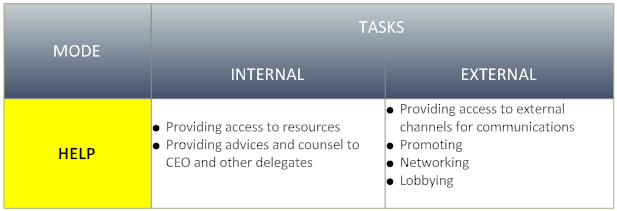The Tasks of Directing
Directing is primarily about getting things done.
Someone has to do the things that either haven't or can't be delegated away. These things are the tasks of directing. As Peter Drucker put it:
"Somebody has to approve the decision what the company's business is and what it should be. Somebody has to give the final approval to the objectives the company has set for itself and the measurements it has developed to judge its progress toward these objectives. Somebody has to look critically at profit planning of the company, its capital investments policy, and its managed expenditure budget... Somebody has to watch the spirit of the organization, has to make sure that it succeeds in utilizing the strengths of people and neutralizing their weaknesses, that it develops tomorrows managers and that it rewards to managers, its management tools and management methods strengthen the organization and directs it toward its objective".
That somebody is the board working with management as a team.
But nothing gets done by just watching and waiting for management to make a mistake. That risk can't be ignored, but there are much greater risks to the corporation if the tasks of directing are ignored or done badly. The strength, resilience and endurance (SRE) of a corporation depends on the board getting the right things done. In other words, directors must also create value.
To ensure the right things get done in the right way and at the right time I use my model of directing that pivots on the four modes or forms of directing.
DECIDE (Trade) - Create value by making the best decisions.
GUIDE - Create value by inspiring and guiding others
HELP - Create value by providing access to resources.
LEARN (Build)- Create value by continually learning.
(over the years I changed trade to decide and build to learn)
Using these four modes of directing I've set out below headings for tasks that share similar characteristics.
Tip : colour code board papers to the mode. It flags to the whole board the right approach to the task.
But this is not just another list of jobs. Lists won't tell a director how to approach a task or when to do it. A list is not a plan.
Historically the tasks of directing have been understood one task at a time. For example, capital strategy and approving a major acquisition are seen as two distinct and unrelated tasks of which there are many. But, using my model it's possible to relate these tasks in a way that will help directors and executives to better understand their work.
Both capital strategy and approving an acquisition are example of decisions that impact on value creation and SRE. In both cases the boards role is similar, designing the commitment, deliberating whether to make the commitment, deciding on the commitment, delivering on the commitments (if not delegated), delegating the commitment and deeming the performance criteria. In other words, though the tasks look different, but they are both decisions and involve the same mental frameworks and behavioral profiles.
What I have created is a simple taxonomy of directing around the four modes of directing. It is a scheme of classification that permits fresh insights into directing. Grouping things collectively rather than individually means it's possible to think creatively and progressively about how to best direct a corporation.
The Tasks of Directing when combined with the Roles of Directing begin to form the base for a systematic plan for ensuring the right things get done in the right way.
TASKS





